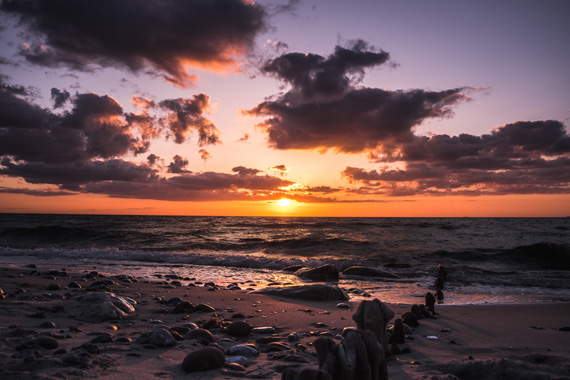Relevant reminder: only 1 day left for the Simply Stunning Landscapes Course at $200 Off
Every evening, as the sun dips below the horizon, we are often treated to a display of vibrant colors splashed across the sky. These sunsets, with their varying hues and intensities, never fail to mesmerize us. But have you ever wondered what kind of weather produces the most awe-inspiring sunsets? Let’s dive in!

Photo captured by Marc Kleen
1. Cloud Cover and Type
Firstly, the presence and type of clouds play a significant role in creating those picturesque sunset scenes. Here’s why:
- Scattered Clouds: A sky with scattered clouds allows the sunlight to be refracted and reflected in multiple ways, leading to a dynamic display of colors.
- High Cirrus Clouds: These thin, wispy clouds located at higher altitudes can catch the last rays of the setting sun, creating brilliant shades of pink and red.
However, a completely overcast sky can dampen the sunset as there’s not enough light to create the hues.
2. Atmospheric Particles
The atmosphere is filled with tiny particles, such as dust, smoke, and pollutants. The presence of these particles can enhance the depth and range of sunset colors.
- Volcanic Eruptions: Large volcanic eruptions can release particles high into the atmosphere, leading to some of the most vivid sunsets. Historically, major eruptions have produced sunsets that have been documented in paintings and literature.
- Pollution: Urban areas often have increased pollutants, which scatter the sunlight in various directions, producing deeper oranges and reds during sunset.
3. Clear Skies
While clouds and particles enhance sunsets, sometimes, the most serene sunsets are observed with clear skies. These sunsets might not have the dramatic flair, but they offer a gradient of pastel colors, transitioning smoothly from one hue to another.
4. Angle of the Sun
During different seasons, the angle at which sunlight enters the atmosphere changes. Around the equinoxes, when the sun sets almost directly in the west, the light has to pass through more of the Earth’s atmosphere, increasing the scattering of blue and green light, and enhancing the reds and oranges.
5. Humidity and Temperature
Higher humidity levels can amplify sunset colors, especially if combined with the right cloud cover. Warm air holds more water molecules which scatter the shorter blue and green wavelengths of light, allowing the longer red wavelengths to dominate.
6. Geographic Location
While not directly related to weather, the geographic location can influence the quality of sunsets. Coastal areas, for instance, tend to have cleaner air, which often leads to sharper and more vibrant sunsets. Mountains can offer a unique play of shadow and light, adding depth to the sunset landscape.
The artistry of sunsets lies in the intricate interplay between light, atmosphere, and the Earth itself. While there is no singular recipe for the “perfect” sunset, various weather conditions can combine to produce a wide array of breathtaking visuals. Whether it’s the fiery reds after a storm or the calm pastels on a clear day, every sunset tells a unique story about our dynamic atmosphere.
For Further Training:
Currently on sale, this course titled “Simply Stunning Landscapes” by Joshua Dunlop, founder of ExpertPhotography, offers a comprehensive guide on mastering the intricacies of landscape photography.

Simply Stunning Landscapes (see what’s covered)
What sets “Simply Stunning Landscapes” apart is its hands-on approach. Instead of confining lessons to theoretical discussions, the course offers practical insights by being shot in various European locations.
Deal ending soon: Simply Stunning Landscapes at $200 Off
Like This Article?
Don't Miss The Next One!
Join over 100,000 photographers of all experience levels who receive our free photography tips and articles to stay current:






Leave a Reply